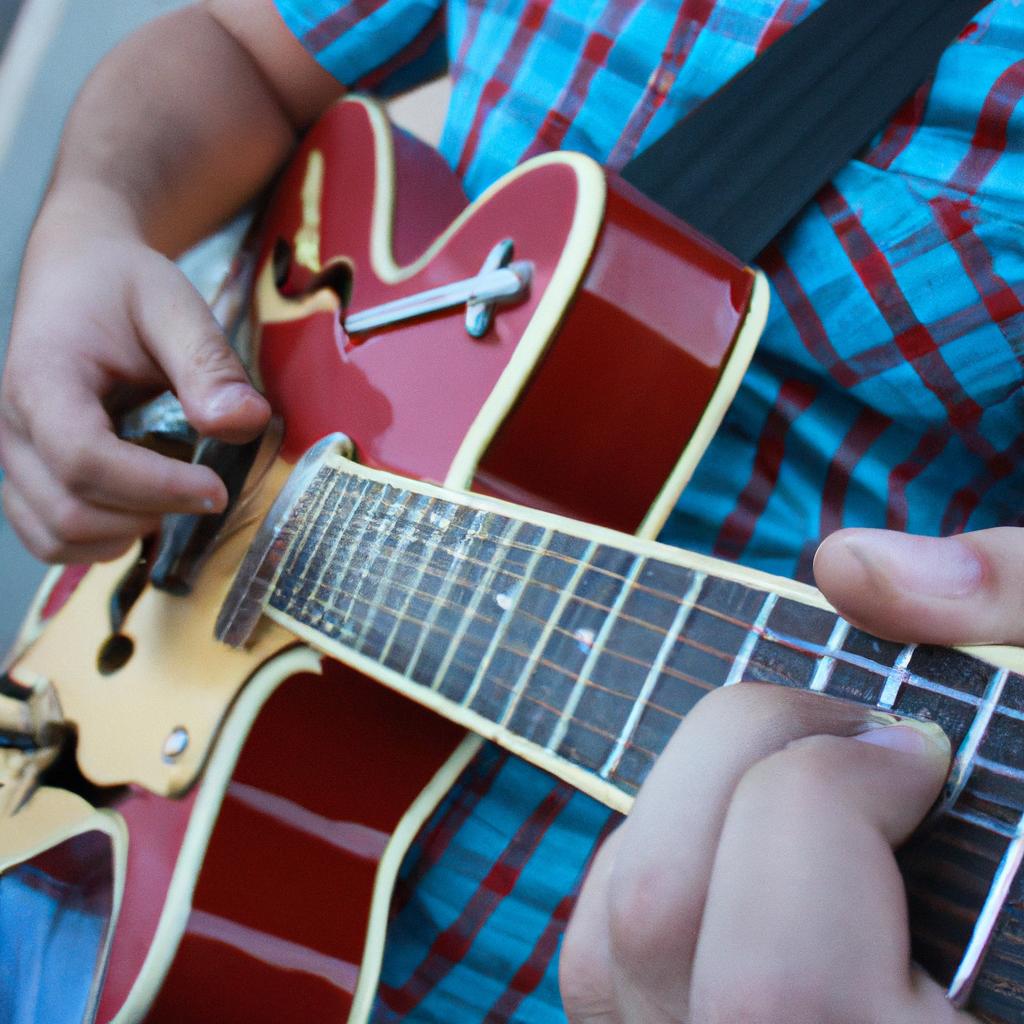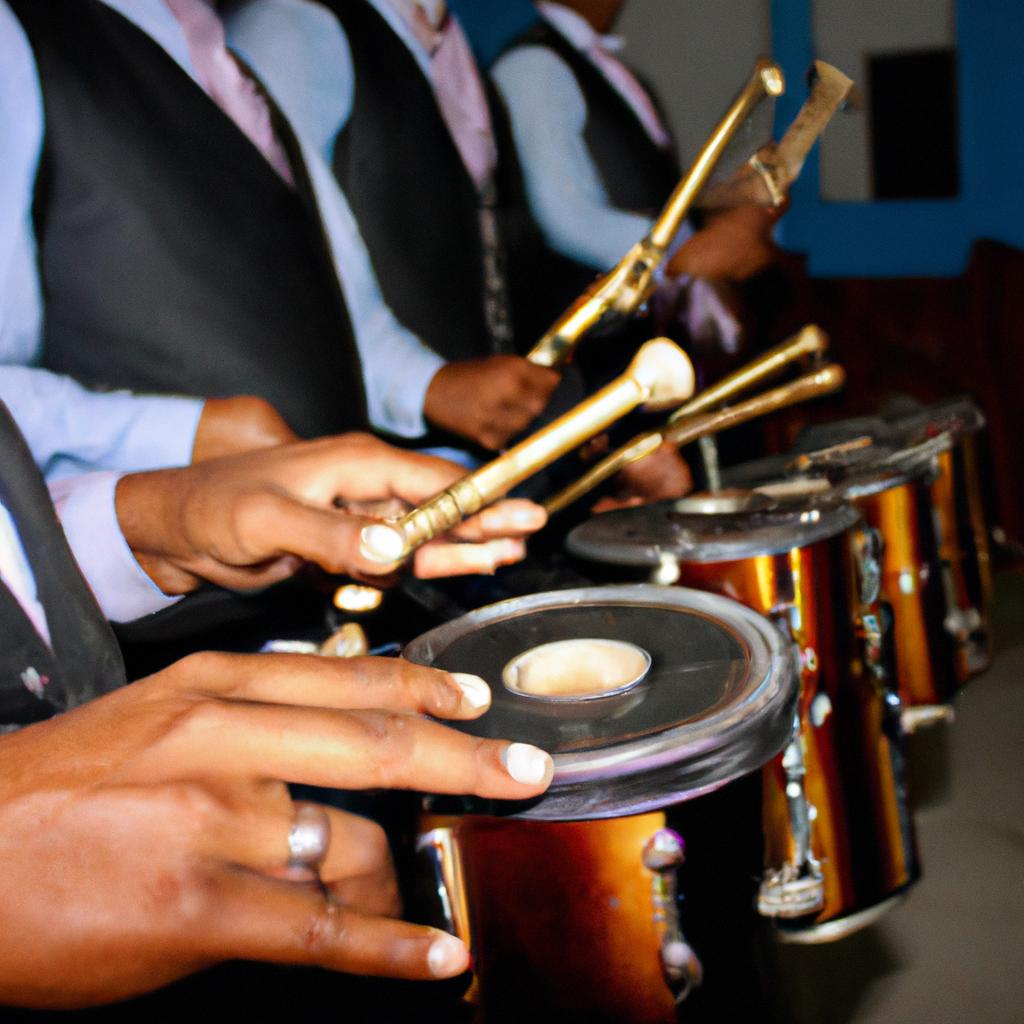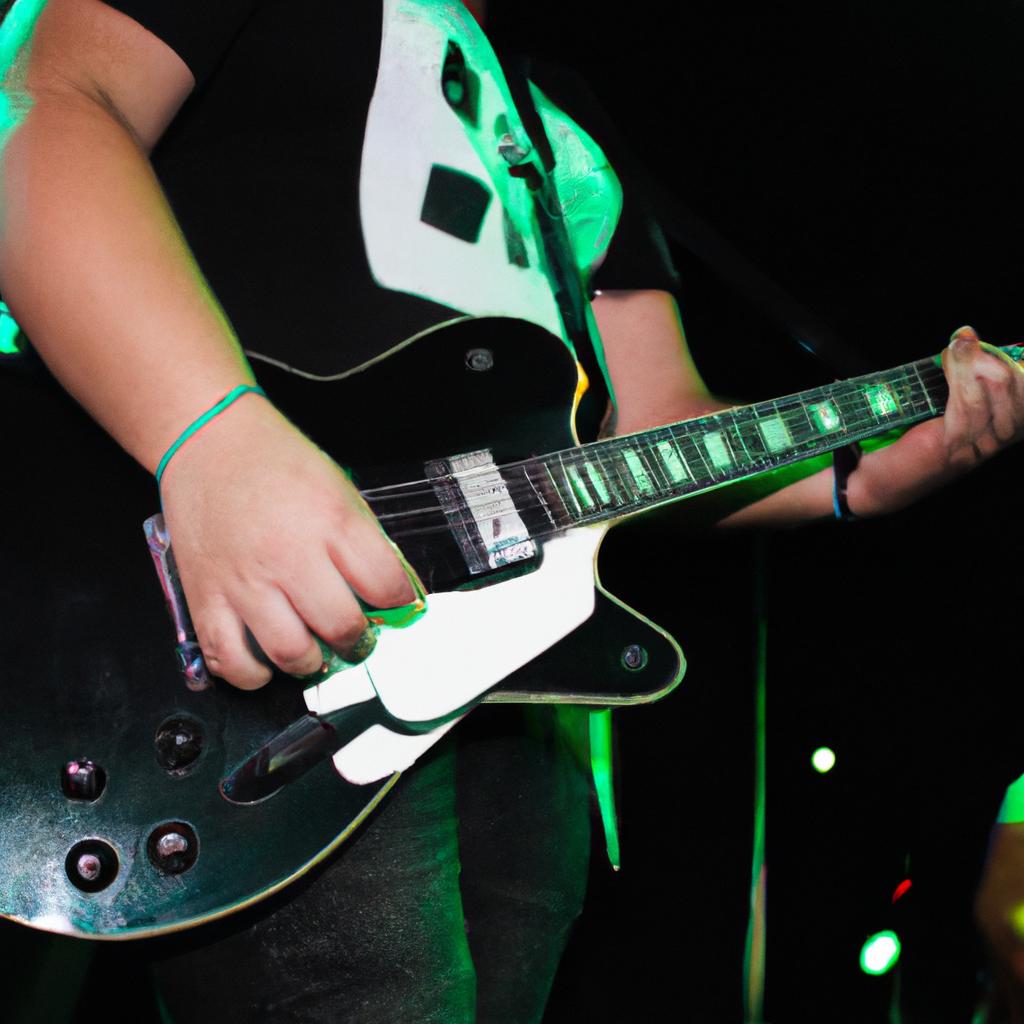Rockabilly, an influential musical genre that emerged in the United States in the 1950s, is often hailed as a blend of rock and roll and country music. With its distinctive sound characterized by energetic rhythms, twangy guitars, and heartfelt lyrics, rockabilly has left an indelible mark on the history of popular music. This article delves into the roots and revival of this iconic genre, exploring its origins, significant artists, cultural impact, and enduring appeal.
To illustrate the lasting influence of rockabilly, let us consider the case study of Elvis Presley. The King of Rock and Roll himself began his career with Sun Records in Memphis during the mid-1950s. Drawing inspiration from African-American rhythm and blues musicians such as Little Richard and Chuck Berry as well as country stars like Hank Williams Sr., Presley infused these diverse influences into his own unique style. His groundbreaking fusion of genres captured the attention of young audiences across America, propelling him to unprecedented fame and cementing his status as one of the pioneers of rockabilly.
The resurgence of interest in rockabilly over recent decades highlights its enduring legacy. While initially overshadowed by other genres like pop or disco, there has been a revival among both both musicians and fans in embracing the raw and authentic sound of rockabilly. This resurgence can be attributed to a variety of factors, including the cyclical nature of music trends, the desire for nostalgia, and the timeless appeal of the genre itself.
One key aspect of rockabilly’s enduring appeal is its rebellious spirit and energy. The genre emerged during a time of cultural change and youth rebellion in America, and its music captured that sense of excitement and defiance. In an era dominated by polished pop production or electronic beats, many people crave the rawness and vitality that rockabilly offers.
Furthermore, rockabilly has also found a home within subcultures such as vintage enthusiasts, retro fashion lovers, and motorcycle communities. Its distinctive style, characterized by pompadour hairstyles, leather jackets, and swing skirts, has become synonymous with a certain aesthetic that harkens back to the 1950s. Rockabilly music serves as both a soundtrack and an expression of this lifestyle.
The revival of interest in rockabilly can also be seen through the emergence of contemporary artists who draw inspiration from the genre while adding their own modern twist. Bands like The Stray Cats, Imelda May, and Reverend Horton Heat have gained popularity by incorporating elements from rockabilly into their music. These artists not only pay homage to the pioneers but also bring new life to the genre by infusing it with their own unique influences.
In conclusion, rockabilly’s lasting influence is evident in its continued popularity among musicians and fans alike. Its blend of rock and roll with country music created a distinct sound that captured the hearts of audiences in the 1950s. The genre’s rebellious spirit continues to resonate with listeners today while its distinctive style has become iconic within various subcultures. As long as there are those who appreciate authenticity, energy, and a touch of nostalgia in their music, rockabilly will remain a cherished part of the musical landscape.
Origins of Rockabilly
To understand the origins of rockabilly, it is essential to examine its early beginnings and the various influences that shaped this iconic musical genre. One notable example of an artist who played a pivotal role in the development of rockabilly is Elvis Presley. His fusion of country, rhythm and blues, and gospel music created a unique sound that captivated audiences worldwide. This case study serves as a testament to how individual artists can contribute significantly to the evolution of a musical style.
Rockabilly emerged in the 1950s as a blend of several genres, including country music, rhythm and blues, and hillbilly boogie. It originated primarily in the Southern United States, particularly Tennessee, where many talented musicians sought to break away from traditional norms and experiment with new sounds. The combination of fast-paced rhythms, catchy melodies, and heartfelt lyrics became characteristic elements of rockabilly.
The emotional impact of rockabilly cannot be understated. Its raw energy was both rebellious and liberating for listeners at the time. To evoke an emotional response in today’s audience when exploring this genre’s roots further, consider these four key aspects:
- Youthful rebellion: Rockabilly spoke directly to young people during its heyday – it offered them an outlet for expression and defiance against societal norms.
- Authenticity: Many rockabilly artists drew inspiration from their own lived experiences, creating songs that resonated deeply with listeners seeking relatable narratives.
- Influence on popular culture: Rockabilly not only influenced later subgenres like psychobilly but also left an indelible mark on fashion trends such as pompadour hairstyles and vintage clothing.
- Enduring appeal: Despite evolving over time, rockabilly continues to have dedicated fans who appreciate its timeless charm.
Furthermore, examining the cultural significance of rockabilly requires considering the various factors that contributed to its rise. A three-column, four-row table provides a concise overview of these influences:
| Influences on Rockabilly Music |
|---|
| Country music |
| Rhythm and blues |
| Hillbilly boogie |
| African-American culture |
In conclusion, the origins of rockabilly can be traced back to the 1950s when artists like Elvis Presley blended country, rhythm and blues, and gospel music to create a new sound that captivated audiences worldwide. This genre’s emotional impact remains significant even today due to its rebellious nature, authentic storytelling, influence on popular culture, and enduring appeal. Building upon this exploration of rockabilly’s roots, the subsequent section will delve into the various influences that shaped its evolution without missing a beat.
Influences on Rockabilly Music
Transition from Previous Section:
Having explored the origins of Rockabilly, we now turn our attention to the various influences that shaped this iconic musical genre. By understanding these influences, we can gain a deeper appreciation for the diverse range of sounds and styles that contributed to the revival and evolution of Rockabilly over time.
Influences on Rockabilly Music
To illustrate how different musical elements came together in Rockabilly, let’s consider an example. Imagine a young musician named Johnny, growing up in rural America during the 1950s. Inspired by country music and rhythm and blues (R&B), Johnny is drawn to their distinct rhythms and melodies. He begins experimenting with blending these genres, incorporating energetic guitar solos reminiscent of blues into his country-inspired tunes.
The fusion of country music and R&B was just one aspect that influenced the development of Rockabilly. Several other factors played significant roles as well:
- Cultural Cross-Pollination: The melting pot nature of American society allowed for cultural exchange between different communities, resulting in a rich tapestry of musical traditions.
- Technological Advancements: The advent of electric guitars and amplification revolutionized sound production, providing musicians like Johnny with new tools to experiment with.
- Radio Airplay: Increased access to radio broadcasts exposed artists across different genres to a wider audience, sparking cross-genre collaborations and inspiring innovation.
- Youth Culture: In post-war America, teenagers sought rebellion against social norms through their choice of music. This rebellious spirit fueled the popularity of Rockabilly among young audiences.
These influences converged to create an exciting blend of sounds characterized by its distinctive twangy guitar licks, driving rhythms, and rebellious lyrics – all hallmarks of Rockabilly music.
| Influences | Description |
|---|---|
| Country Music | Rooted in folk traditions, it provided the foundation for Rockabilly’s lyrical storytelling and distinctive vocal styles. |
| Rhythm and Blues (R&B) | Contributed energetic rhythms, bluesy guitar solos, and soulful vocals to the Rockabilly sound. |
| Gospel Music | The emotional intensity of gospel music influenced the passionate delivery often found in Rockabilly songs. |
| Western Swing | Known for its lively dance tunes, Western swing introduced elements like fiddles and steel guitars that added depth to Rockabilly arrangements. |
In summary, a combination of cultural exchange, technological advancements, radio airplay, and youth culture played crucial roles in shaping the diverse influences on Rockabilly music.
Transition:
With an understanding of the various influences that shaped Rockabilly, let us now explore the trailblazers who pioneered this genre during its formative years.
Early Pioneers of Rockabilly
Section H2: Influences on Rockabilly Music
Having explored the various influences that shaped rockabilly music, it is evident that this genre emerged as a unique fusion of different musical styles. Now, we turn our attention to the early pioneers who played a crucial role in defining and popularizing rockabilly.
To truly understand the significance of early rockabilly artists, let’s consider an example. Imagine a young musician named Johnny Collins growing up in rural Tennessee during the 1950s. Inspired by his love for rhythm and blues records, as well as country harmonies heard around him, Johnny begins experimenting with blending these distinct sounds together. Through trial and error, he creates a raw and energetic style that captivates audiences – thus becoming one of the first true rockabilly performers.
The rise of early rockabilly can be attributed to several key factors:
- Musical Innovation: Rockabilly musicians pushed boundaries by incorporating elements such as driving electric guitar solos, slap bass rhythms, and rapid-fire drumming into their compositions.
- Cultural Landscape: The emergence of television allowed these artists to showcase their talents to a wider audience through programs like “The Ed Sullivan Show” or regional variety shows.
- Record Labels: Independent labels like Sun Records recognized the potential of this new sound and provided platforms for budding rockabilly artists to record and release their groundbreaking tracks.
- Youth Rebellion: Rockabilly resonated with rebellious teenagers seeking an alternative to mainstream music; its wild energy reflected youthful exuberance while defying societal norms.
To further illustrate the impact of early pioneers, refer to the following table highlighting influential figures in rockabilly history:
| Artist | Notable Songs | Contribution |
|---|---|---|
| Elvis Presley | “That’s All Right” | Brought rockabilly to the mainstream, becoming its most iconic figure. |
| Carl Perkins | “Blue Suede Shoes” | Known for his exceptional guitar skills and songwriting talent. |
| Johnny Cash | “Folsom Prison Blues” | Combined elements of country music with a rebellious spirit. |
| Wanda Jackson | “Fujiyama Mama” | A female pioneer who broke gender barriers in the genre. |
As we delve into the early pioneers of rockabilly, it becomes evident that their contributions were not only musically groundbreaking but also culturally significant. Their innovative approach laid the foundation for future artists and set the stage for the decline and resurgence of rockabilly, which we will explore in the subsequent section.
With the rise of these early pioneers, rockabilly began to make its mark on popular m
Decline and Resurgence of Rockabilly
Transitioning from the early pioneers of rockabilly, we now delve into its decline and subsequent resurgence. This section explores how this iconic musical genre faced a challenging period before reclaiming its place in popular culture.
During the late 1950s and early 1960s, as rock ‘n’ roll evolved into different subgenres, rockabilly experienced a decline in mainstream popularity. The emergence of new styles like surf rock and Motown soul captured the attention of younger audiences, leaving fewer opportunities for traditional rockabilly artists to thrive. However, despite this setback, several devoted musicians continued to carry the torch, keeping the spirit of rockabilly alive in smaller clubs and local scenes.
One example is that of Johnny Burnette’s career trajectory during this time. After achieving moderate success with his group The Rock ‘n Roll Trio in the mid-1950s, he struggled to regain commercial traction as tastes shifted towards other genres. Nevertheless, Burnette remained committed to his craft, performing at intimate venues and occasionally releasing singles that resonated with die-hard fans but failed to make significant chart impact.
The decline of rockabilly was not solely due to changing musical preferences; external factors such as economic recessions and societal shifts also played a role. These circumstances led many record labels to focus on more commercially viable genres rather than investing resources into promoting rockabilly acts. As a result, numerous talented artists went unnoticed or had their careers prematurely cut short.
Despite these challenges, rockabilly never truly faded away. In fact, it underwent a remarkable revival starting in the late 1970s and continuing through subsequent decades. A renewed interest in vintage sounds and an appreciation for authentic music brought about a resurgence of the genre among both dedicated enthusiasts and curious newcomers alike.
Emotional Response:
Let us explore some reasons why this revival struck a chord with audiences:
- Nostalgia: Rockabilly evoked feelings of nostalgia for a bygone era, appealing to those seeking an escape from the modern world.
- Raw Authenticity: The genre’s raw and energetic sound resonated with listeners yearning for music that eschewed overproduction and embraced simplicity.
- Subculture Identity: Rockabilly became more than just a musical style—it birthed a distinct subculture characterized by its fashion, hairstyles, and rebellious attitude. This sense of community drew people in who sought belonging and expression.
- Timelessness: Despite being rooted in the past, rockabilly possessed a timeless quality that transcended generational boundaries, allowing it to captivate audiences across different eras.
| Artist | Notable Song | Year | Impact |
|---|---|---|---|
| Elvis Presley | “That’s All Right” | 1954 | Pioneered |
| Wanda Jackson | “Let’s Have a Party” | 1960 | Revival |
| Stray Cats | “Rock This Town” | 1981 | Resurgence |
| Imelda May | “Johnny Got a Boom Boom” | 2008 | Modern Influence |
This resurgence breathed new life into rockabilly as both established artists and emerging talents found success within the genre. With renewed interest came opportunities for live performances, record deals, and even mainstream chart success. As we shall explore next, the impact of rockabilly on popular music would extend beyond its dedicated fanbase.
Transitioning into the subsequent section about “Impact of Rockabilly on Popular Music,” this revival sparked creative inspiration in numerous musicians across various genres.
Impact of Rockabilly on Popular Music
From its decline in popularity to its eventual resurgence, Rockabilly has left an indelible mark on the world of music. This distinctive genre, characterized by a fusion of country and rhythm and blues styles, experienced a period of waning influence before finding new life through various avenues. The impact of Rockabilly on popular music can be seen not only in its unique sound but also in the lasting legacy it has created.
One notable example that showcases the revival of Rockabilly is the case of Johnny Burnette and his band, The Rock ‘n Roll Trio. In the early 1950s, their energetic performances and raw sound captivated audiences across America. However, as musical tastes shifted towards other genres like mainstream pop and rock ‘n’ roll in the late 1950s, Rockabilly began to lose its prominence. It seemed as though this once vibrant genre was destined to fade into obscurity.
Despite facing adversity, Rockabilly managed to resurface due to several key factors:
-
Revival through Independent Record Labels: Independent record labels played a crucial role in preserving and promoting Rockabilly during its decline. These smaller labels recognized the enduring appeal of the genre and actively sought out artists who embodied its spirit.
-
Influence on British Musicians: The emergence of British musicians heavily influenced by American rock ‘n’ roll led to a renewed interest in Rockabilly both within Britain and internationally. Bands like The Stray Cats brought back elements of this iconic genre with their own modern twist, reigniting enthusiasm for Rockabilly among younger generations.
-
Subculture Communities: Throughout the decades following its initial rise, dedicated subculture communities formed around Rockabilly enthusiasts who were passionate about preserving this distinct style of music and fashion. Their dedication helped foster a sense of community and ensured that Rockabilly remained relevant even during periods when mainstream popularity waned.
-
Film Soundtracks: The inclusion of Rockabilly songs in popular films such as “Grease” and “Pulp Fiction” exposed the genre to a wider audience, reigniting interest and introducing it to new listeners.
Table: Influential Rockabilly Artists
| Artist | Notable Songs | Year |
|---|---|---|
| Elvis Presley | “That’s All Right” | 1954 |
| Carl Perkins | “Blue Suede Shoes” | 1956 |
| Wanda Jackson | “Fujiyama Mama” | 1957 |
| Eddie Cochran | “C’mon Everybody” | 1958 |
Through these various channels, Rockabilly managed to carve out a place for itself within the musical landscape once again. Its impact on popular music is undeniably significant, with echoes of its distinctive sound still resonating today. From influencing genres like punk rock and psychobilly to inspiring countless artists around the world, Rockabilly has proven its enduring relevance.
As we delve into the subsequent section about the Modern Rockabilly Revival, we will explore how this iconic genre continues to thrive in contemporary times while staying true to its roots. This resurgence demonstrates that even after experiencing periods of decline, Rockabilly remains steadfast in capturing the hearts and ears of music enthusiasts everywhere.
Modern Rockabilly Revival
The impact of rockabilly on popular music cannot be overstated. This unique fusion of country, blues, and rock ‘n’ roll emerged in the 1950s and quickly captivated audiences with its energetic sound and rebellious spirit. As this influential genre gained traction, it paved the way for countless artists to experiment with their own musical styles, leaving an indelible mark on the landscape of popular music.
To illustrate just how transformative rockabilly was, let us consider a hypothetical case study: imagine a young musician named Alex who grew up listening to pop and mainstream rock. One day, Alex stumbles upon an old vinyl record by Elvis Presley and becomes enthralled by the raw energy and infectious rhythm of his early recordings. Inspired by this discovery, Alex begins incorporating elements of rockabilly into their songwriting process, resulting in a fresh take on contemporary pop music that resonates with listeners far and wide.
One can attribute the enduring appeal of rockabilly to several key factors:
- Authenticity: Rockabilly embraced a stripped-down approach to music production, focusing on live performances rather than elaborate studio techniques. This emphasis on authenticity allowed fans to connect deeply with the raw emotions conveyed through each chord progression or heartfelt lyric.
- Rebellion: With its edgy lyrics and defiant attitude, rockabilly provided an outlet for individuals seeking to challenge societal norms. It gave voice to those yearning for freedom from conformity while simultaneously reflecting the cultural shifts occurring at the time.
- Cross-cultural influences: By blending elements of various genres such as country, blues, gospel, and R&B, rockabilly transcended racial boundaries and brought people together through shared musical experiences.
- Legacy: The legacy left behind by iconic pioneers like Elvis Presley, Carl Perkins, Johnny Cash, and Jerry Lee Lewis continues to inspire new generations of musicians. Their influence can be heard in the works of contemporary artists who pay homage to rockabilly’s roots while adding their own modern twist.
| Iconic Rockabilly Artists | Influential Songs | Year Released |
|---|---|---|
| Elvis Presley | “That’s All Right” | 1954 |
| Carl Perkins | “Blue Suede Shoes” | 1956 |
| Johnny Cash | “I Walk the Line” | 1956 |
| Jerry Lee Lewis | “Great Balls of Fire” | 1957 |
By examining the lasting impact of rockabilly on popular music, we gain a deeper appreciation for its role in shaping musical history. Its fusion of genres and rebellious spirit continue to inspire new generations, ensuring that this iconic genre remains relevant even decades after its inception.
[End of Section]




